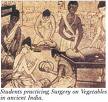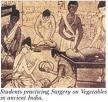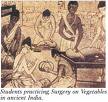Greater Triad
Charaka samhita

Charaka was a physician who was always traveling. He was a disciple of Agnivesha who wrote the Atreya Samhita. Charaka rewrote the Agnivesha samhita (in about 1000 BC). Around 400 AD, Drdabala worked upon charaka samhita and re-formed it. This re-formed version of Drdabala is available to us as the "Charaka samhita".
Many chapters in Charaka samhita are in the form of symposiums; where in groups of sages take in certain topics for discussion. The text, which is written in Sanskrit, is in the form of prose and verses. It contains 8,400 metrical sentences. The focus is on "Kaya chikitsa" the internal medicine, which aims to balance the "Agni",or the digestive fire, responsible for metabolism.
Susruta samhita

The word "Susruta" means "one who listens very well". Susruta was a surgeon. He was the disciple of Divodasa Dhanvantari of the Dhanvantari lineage. The text belongs to around 6th century BC. Due to his contribution to surgery he is termed as "Father of surgery."
Later, around the 2nd century BC, the text was re-edited by Nagarjuna. The text explains various surgical procedures and includes techniques to repair torn ear lobe, cleft palate and disfigured nose, uniting the torn intestines, removal of prostrate gland, removal of cataract, draining of abscesses and also some surgical procedures in the brain. He has explained about the dissection of cadavers and the method to preserve them besides describing 101 kinds of blunt instruments (yanra) and 20 kinds of sharp instruments (shastra).
Ashtanga Sangraha

Around 5th century AD, Vagbhatta compiled a treatise named Ashtanga sangraha. It combines both the above treatises, explaining all the 8 parts of Ayurveda including, Kaya chikitsa (internal medicine) and Shalya tantra (surgery).
Ashtanga sangraha excels in explaining the basic concepts of Ayurveda. It explains all the basics of Ayurveda, such as the
• Theory of 5 elements (panchamahabuta tatva)
• Theory of 3 functional principles (tridosha siddhanta)
• Theory of 7 structural principles (sapta dhatu tatva)
• Theory of 6 tastes (shad rasa siddhanta)
Seeing that the text Ashtanga sangraha is very elaborate the same author Vagbhatta has also written a text called 'Ashtanga hrdayam'. Ashtanga hrdayam is more concise; it covers all the 8 parts of Ayurveda.
Ashtanga sangraha is written in both prose and in the poetry form while Ashtanga hrdayam is completely written in poetry form, which is easy to memorize.
The Eight Branches of Ayurveda
Ashtanga Ayurveda
Kaya chikitsa (Internal medicine)
Baala chikitsa (Pediatrics)
Graha chikitsa (Demonology)
Urdhvanga Chikitsa (Diseases of head & neck)
Shalya chikitsa (Surgery)
Visha chikitsa (Toxicology)
Jara chikitsa (Rejuvenation)
Vrsha chikitsa (Aphrodisiac therapy)
"Kaaya baala graha urdhvaanga shalya damshtra jara vrshan Ashtau angaani tasyaahuh chikitsa yeshu samsthitaah."
-Ashtanga hrdayam
Ayurveda has 8 branches in it. They are:-
Kaaya Chikitsa (Internal Medicine)

The word 'Kaya' represents 'Agni' - the digestive fire in the body. It is responsible for the metabolism in the body. The imbalance to this 'Agni' is the cause for many diseases. Kaya chikitsa deals with the treatment of general ailments, such as fever, diarrhea and cough, by treating Agni
Baala Chikitsa (Treatment of Children / Pediatrics)

This deals in treating children. This is also called kumara Brtya. There are three aspects that must be remembered while treating children-
• Children cannot explain their complaints
• The dosage of medicine is different for them
• The medicines given to them must be palatable to them.
Due to these conditions, treating children is done in a different manner. Hence a separate branch is devoted for them.
Graha Chikitsa (Demonology / Psychology)

This branch of Ayurveda deals with diseases like insanity, epilepsy and diseases caused by affliction of external factors such as evil sprits and ghosts. In other words it may be known as the branch that deals with the treatment of psychosomatic diseases.
Urdhvaanga Chikitsa (Treatment of disease above the clavicle),

ENT and Ophthalmology (Urdhvanga Chikitsa or Shalakya tantra),This branch includes the description and treatment of diseases of head, ear, nose, throat, and eye. Sushrut Samhita and Ashtanga Hridaya stipulate drug therapy of different types of conjunctivitis and glaucoma, along with surgical procedure of the removal of cataract and cosmetic surgery such as rhinoplasty and auroplasty (reformation of traumatized nose and ear). Apart from these complicated diseases, a simple home remedial approach of these ancient scholars towards minor problems like wax in ear, dryness of eyes due to fatigue, coryza, migraine, mouth ulcers etc. form a base for the home remedies, which are successfully administered even today.
Shalya Chikitsa (Surgery)

Surgery is not an invention of modern medicine. It was highly advanced in several ancient cultures, including those of India, Greece and Egypt. But Ayurveda is the pioneer in the art of surgery. A number of surgical procedures like resection of the obstructed intestinal loop, surgical removal of bladder stone, surgical management of ascites, excessive hemorrhage etc. have been described in Sushrut Samhita and Ashtanga Hridaya.
Damstra Chikitsa (Toxicology)

This branch deals with various natural poisons/toxins originating from minerals, plant and animal kingdoms as well as artificial poisons prepared from poisonous drugs. The description is available in all the three treatises i.e. Charak Samhita, Sushrut Samhita and Ashtang Hridaya. It also includes description and disadvantage of food of opposite qualities, drugs and food causing chronic poisoning symptoms, and different methods used in ancient times to administer poison in an enemy's body system. Interestingly, the concept of pollution of air and water has also been considered. Such pollution is said to be the cause of various epidemics and the reason for the collapse of several civilizations.
Jara Chikitsa (Geriatrics, Rejuvenation)

It is described in detail in Charak Samhita and a brief account is given in Ashtanga Hridaya and Sushrut Samhita. This therapy is used to prevent diseases and promote a long, healthy life by delaying old age and increasing longevity. The rejuvenation process requires that we observe the Right conduct in life. This is described under the title of Aachara Rasayana.
Vrsha Chikitsa (Aphrodisiac therapy)

This branch discusses the therapeutic use of various aphrodisiacs for enhancing the vigor and sexual capability of males. It also includes the description of drugs, which improve sexual capacity by controlling premature ejaculation or/and by curing other male sexual disorders.
In contrary to the popular misbelief, Ayurveda is not a mere alternative therapy but a way of life, which, if followed religiously, can help one attain a better physical, emotional, social and spiritual life through which one can attain:
Dharma (One's duty towards one's own self)
Artha (One's duty towards one's family)
Kama (Fulfillment of all the worldly desires)
Moksha (Salvation)
